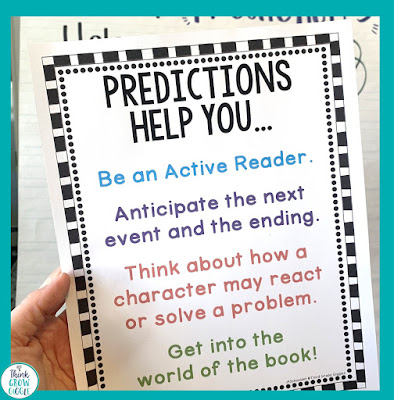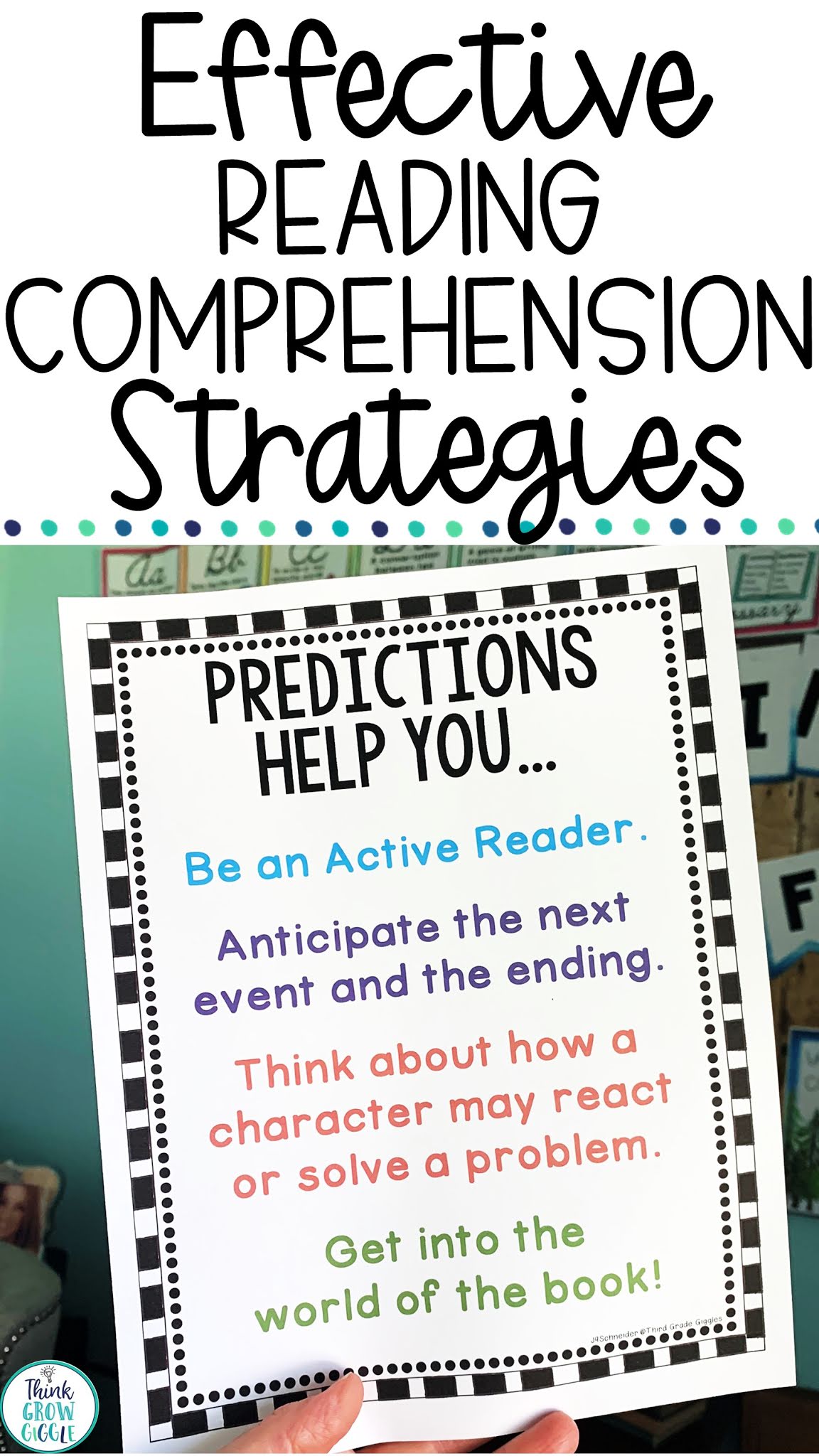Making meaningful predictions is an important reading strategy that students must master as they begin to read more complex texts in the upper elementary classroom. Predicting requires students to collect information from the book that they are reading and think ahead to make an educated guess about what will happen next. Making predictions helps students:
- Be an active and alert reader.
- Anticipate the next event and ending of the book.
- Think about how a character may react or solve a problem.
- Get into the world of the book.
As we teach students to make predictions, we must be sure that students are making valid and reasonable predictions that are not just based on what is happening in the book that they are reading, but also supported by their own personal experiences. This is no easy task! So how can we get students to make meaningful predictions as they read to help them be active readers and better understand the books that they are reading? Here are four simple ways to help your students make meaningful predictions and grow as readers, even as the books that they are reading increase in complexity.
Explicit Instruction
 As students get older and read more complex books, they should still be making and discussing predictions. While in the younger grades, students primarily made predictions based on the cover of the book. As the books they are reading increase in difficulty and length, students have to be able to hold on to information as they read for longer periods of time to be able to make predictions through the end of the book. Since students use a combination of text clues and personal experience to predict what will happen as they read, students can sometimes confuse making predictions with making inferences. The main difference between predicting and inferring is that by the end of the student's reading, the predictions that they have made can be confirmed to be correct or not, while the inferences that they make cannot. This is primarily because the inferring that they do as they read is based on implied or indirect information that they gather through the questions that they ask as they read. Since students at this age are learning to balance multiple reading strategies as they read, they still need explicit instruction on how to use different reading strategies like making predictions, both in isolation and simultaneously with other strategies.
As students get older and read more complex books, they should still be making and discussing predictions. While in the younger grades, students primarily made predictions based on the cover of the book. As the books they are reading increase in difficulty and length, students have to be able to hold on to information as they read for longer periods of time to be able to make predictions through the end of the book. Since students use a combination of text clues and personal experience to predict what will happen as they read, students can sometimes confuse making predictions with making inferences. The main difference between predicting and inferring is that by the end of the student's reading, the predictions that they have made can be confirmed to be correct or not, while the inferences that they make cannot. This is primarily because the inferring that they do as they read is based on implied or indirect information that they gather through the questions that they ask as they read. Since students at this age are learning to balance multiple reading strategies as they read, they still need explicit instruction on how to use different reading strategies like making predictions, both in isolation and simultaneously with other strategies.Initial explicit prediction instruction should include lessons focused on:
- What a Prediction Is
- How to Make a Prediction
- How Predictions Help Readers Grow
- When to Make Predictions
- The Difference Between a Prediction and Inference
These lessons are perfect to teach using picture books to model how to make predictions. There are so many great books to use help students master making predictions. The key to picking a book to use for prediction lessons is to make sure that students have not heard the story! Sounds simple, but often times as teachers we pick our favorite books to share with students. This increases the chances of the students having heard the book before. One way to check to see if students have heard a story before you read it is to leave the book out in a spot where students can see the book, but not take it to read. Students will quickly tell you that they have heard that book before! My favorite books to use for prediction lessons are Enemy Pie* and Too Many Pumpkins*. These books have story lines that offer many story clues to collect and relatable story lines that will help students make valid predictions. (Grab free prediction teaching points to guide your lessons below.)
Use a T-Chart Organizer
An important step in teaching students to make predictions is to show them the connection between collecting and recording story clues and their own experiences with making valid predictions. As you read aloud with students to practice, simply chart story clues on chart paper, have students share their experiences and record them. Then pause to allow students time to make predictions based on both pieces of information that you have written down. This is critical so that students see the point in taking notes to collect story evidence! A simple graphic organizer like a T-chart, is a great way for students to visually see how the story clues that they are reading are driving their recollection of past experiences and the predictions that they make. Once you have practiced this together, students can work independently collecting information to help them make predictions using a range of graphic organizers from a simple bullet list to more complex graphic organizers. I have found that students love the simplicity of the T-chart like the one pictured above. Since it is easy to make, students can use plain paper or notebook paper to keep track of the story clues, their experiences, and the predictions that they make. Having any organizer makes it easier for students to turn their prediction ideas into written reflections about books. (Grab free prediction teaching points to guide your lessons below.)Before, During, and After Reading Tasks
 Making predictions is a strategy that students use throughout reading an entire book. Do not let students falsely think that predictions are made only at the beginning of a new book or new chapter. While it is important to predict at these times, good readers make predictions throughout the whole book, on each and every page. While focusing on making predictions, try using "before, during, and after reading tasks" to reinforce prediction making throughout the text. I love using using these types of tasks because it allows readers to complete a task based on the lesson of the day, no matter where they are in the book that they are reading. To make these, I simply decide on a prediction task that students can complete whether they are just beginning a book, knee deep in a book, or just wrapped up a book. You can assign students a before, during, and after task, allow them to select one, or simply write a prediction task on chart paper and have every student respond to it on a sticky note by the end of reading. (Grab these before, during and after tasks activities for free below.)
Making predictions is a strategy that students use throughout reading an entire book. Do not let students falsely think that predictions are made only at the beginning of a new book or new chapter. While it is important to predict at these times, good readers make predictions throughout the whole book, on each and every page. While focusing on making predictions, try using "before, during, and after reading tasks" to reinforce prediction making throughout the text. I love using using these types of tasks because it allows readers to complete a task based on the lesson of the day, no matter where they are in the book that they are reading. To make these, I simply decide on a prediction task that students can complete whether they are just beginning a book, knee deep in a book, or just wrapped up a book. You can assign students a before, during, and after task, allow them to select one, or simply write a prediction task on chart paper and have every student respond to it on a sticky note by the end of reading. (Grab these before, during and after tasks activities for free below.)Illustrate the Ending
My students love any and all activities that allows them to be creative! Tying art and reading together always means instant engagement in my classroom! Have students who are almost finished with a chapter book illustrate the ending by rereading the predictions that they made during the book. Their illustration should represent what would be on the last page of the book. This activity makes a great visual reminder that the predictions they make are based on text evidence, clues, and their own experiences that they have carried throughout the whole book.Making predictions is a reading strategy that truly engages the reader. When students make predictions as they read they become excited to forge ahead to see what happens next. After students practice how to make predictions explicitly, it becomes second nature. Making predictions is a must teach reading strategy as it lays the ground work for more complex reading strategies like inferring and making connections. What is your favorite making predictions activity?
Related Articles: Visualizing Activities to Keep Students Actively Reading
Love these ideas? Pin for later!
*affiliate links: “Think Grow Giggle is a participant in the Amazon Services LLC Associates Program, an affiliate advertising program designed to provide a means for sites to earn advertising fees by advertising and linking to Amazon.” (source: Section 5)






















